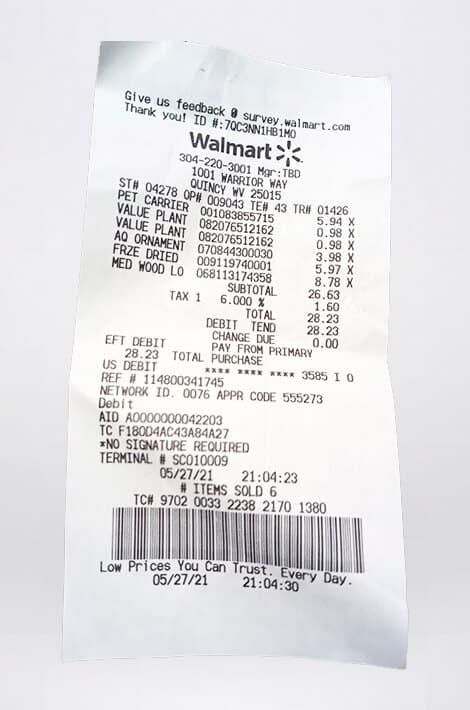Last Updated on May 21, 2025
The True Capabilities of a Receipt OCR API
Whilst extracting all the data fields from a POS receipt might seem simple enough, things are not quite what they seem. Some data fields are much more generic than others. With millions of different formats around the globe in many different languages, even the most well-trained OCR machine-learning models may have difficulty with certain data points. Let’s take a deeper look at the problem and see what can really be done.
Core Data Fields
At its most basic level, a Receipt OCR API is designed to extract the core elements commonly found on any receipt. These include:
- Vendor Name and Address: Identifying the retailer or service provider is crucial for record-keeping. Receipt OCR systems can pinpoint the business name and its location, often found at the top of the receipt.
- Transaction Date and Time: This information is essential for accounting and audit trails. The API identifies the date and time of purchase, which can also be useful for warranty claims or tracking spending patterns.
- Total Amount: Arguably the most critical piece of data, the total cost of a transaction is prominently extracted. This includes not just the subtotal but also taxes and tips if applicable.
These fields are generally the most accurately extracted fields within a POS receipt and the ones that a machine-learning model focuses on getting right. Although there vary from receipt to receipt in terms of positioning and placement, there are many common patterns that can be picked on and trained to a very high level of accuracy.
- Tax Breakdown: For businesses that need to track VAT, GST, or other sales taxes, a Receipt OCR API can capture the precise tax amount and rate. This feature is particularly useful for compliance and filing tax returns.
These fields do vary from region to region and can normally be extracted fairly well globally however, passing a regional parameter through the API will tend to increase accuracy due to different types of tax and formats within different countries.

Item-Level Data Extraction
Modern Receipt OCR APIs don’t stop at summarizing transactions. They can perform item-level extraction, pulling detailed information about every product or service listed on a receipt.
Whist line item data can be extracted well, the quality of a receipt image is much more important for high levels of accuracy. Due to the nature of the repetitive lines, any warping and skewing can cause duplicate or wrongly allocated line data to be extracted and so a fairly straight and well-photographed receipt has the best chance at accuracy. For a better understanding you can check our Receipt Image Guidance Document.
Some common fields are:
- Item Names: From a latte to a laptop, the API identifies product or service names line by line.
These will be extracted accurately when ready however matching accurately to products is another story which Tabscanner can assist with through its own proprietary matching algorithm.
- Quantities and Prices: These systems can parse how many units of each item were purchased and their respective costs, aiding in inventory management and expense tracking.
These can also be extracted accurately however, if extremely high accuracy levels are required, some custom training/ configurations can be applied for higher accuracy on specific formats. This is usually a good option if the solution is for a closed batch set of receipts such as specific retailers within a loyalty program like in a mall or set of supermarkets looking for specific products or items.
Discounts and Promotions: If a receipt includes discounts, coupons, or promotional offers, these details are also captured, providing insights into savings and customer loyalty programmes.
These data fields are very bespoke and often vary a lot from format to format. Custom training and configs are highly advised to search out specific discount codes and vouchers from these formats and this is where Tabscanner’s data team’s expertise can really help customers.

Payment Information
In addition to capturing what was purchased, Receipt OCR APIs can also extract payment-related data, such as:
- Payment Method: Whether the transaction was completed via cash, credit card, or digital wallet is often recorded.
- Last Four Digits of the Card: For security and tracking purposes, some receipts include the final digits of the payment card used. Receipt OCR systems can recognize and extract this detail.
These are usually extracted very well straight out of the box due to the limited nature of card providers.
Additional Metadata
Beyond the obvious, Receipt OCR APIs can pull less prominent yet equally valuable metadata. For instance:
- Receipt Number or Transaction ID: This unique identifier helps businesses track and reference individual transactions.
- Store or Terminal ID: Useful for multi-location businesses, this data allows companies to pinpoint where each transaction occurred.
- Customer Information: Some receipts include customer names or loyalty card numbers, which the API can extract for CRM (Customer Relationship Management) systems.
These fields would benefit from some specific customisation if within a closed batch scenario and like granular line item information, Tabscanner can provide custom-trained models to extract these for specific use cases.
Multilingual and Multi-Currency Capabilities
One of the standout features of many Receipt OCR APIs is their ability to process receipts in multiple languages and currencies. This is especially beneficial for global businesses or travelers who need to manage expenses across borders.
Tabcsanners regional parameters can greatly help with this and passing the regional parameters by detecting the geo location of a user can automate this process very effectively. You can see more about our regions parameters within our documentation

The Benefits of Automating Data Extraction
For businesses, the ability to extract such comprehensive data offers significant advantages. It reduces the time and error associated with manual data entry, enhances financial transparency, and supports better decision-making. Whether it’s for bookkeeping, expense reporting, or customer analytics, a Receipt OCR API provides a seamless and reliable solution.
In conclusion, the types of data a Receipt OCR API can extract go far beyond mere totals and dates. These systems are a technological leap, offering detailed, accurate, and actionable insights from every transaction. As the technology continues to evolve, we can expect even greater sophistication and utility in how businesses handle their receipt data.
Test out our free receipt OCR uploader to get an idea of how fast and accurate we are straight out of the box!



